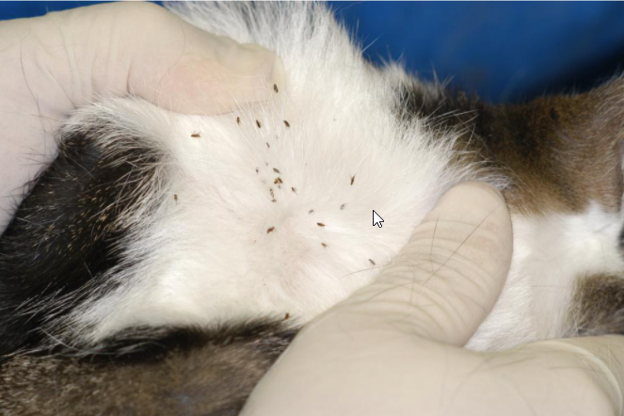Pest season is here. While pests can plague us throughout the year, May, June, and July are the peak months for pests in Texas. Pest prevention is the best remedy. But before we go into flea and tick prevention, it helps to know how to detect and eliminate them.
Flea and Tick Prevention Begins with Recognizing the Problem
Ticks and fleas are nasty pests that can live in your pet’s fur and bite it to feed on its blood. One of the scariest things about them is that they can each potentially transmit disease to your pet.
To be successful at managing these pests, you need to know what the different pests look like and how to recognize when your pet has an infestation.
Recognizing a Tick Problem:

There are many varieties of ticks. The most common in Texas are:
- American Dog Tick
- Lone Star Tick
- Brown Dog Tick
- Black Legged Tick
For pictures and information about the various types of ticks, visit PestWorld.org.
Symptoms of a possible infestation:
- Licking or chewing: Your pet may lick or chew at the spot on their body where the tick is attached.
- Inflamed skin: The skin around where the tick is attached will become red and inflamed.
- Anemia (not enough red blood cells): Anemia may occur if your pet has multiple ticks, leading to excessive blood loss and resulting in pale gums and lethargy.
List of Common Tick-Born Diseases that Can Affect Pets
- Lyme Disease
- Ehrlichiosis
- Anaplasmosis
- Rocky Mountain Spotted Fever
- Babesiosis
- Hepatozoonosis
- Tick Paralysis
These diseases can vary in severity and clinical signs, and some may have overlapping symptoms. Pet owners must be vigilant about tick prevention and promptly remove any ticks found on their pets to reduce the risk of these diseases.
Recognizing a Flea Problem

Photo Courtesy of Dr. Michael W. Dryden
Some people think that a few fleas on their pet will not harm their pet. However, a pet can suffer from an allergic reaction from just one single flea bite. Additionally, fleas reproduce quickly and abundantly. A female lays up to 50 eggs per day! Here are some signs that can help you spot a flea problem:
- Excessive scratching or biting at their skin: Your pet will scratch and bite at the spot where the flea bites them. Not only can a flea’s bite be painful, but they also excrete a substance that causes irritation and itching.
- Flea “dirt”: Flea dirt is actually flea poop! When fleas live on animals like cats or dogs, they feed on their blood. Then, they poop out little black specks that look like tiny grains of pepper. That’s flea dirt. How can you tell the difference between dirt and flea dirt? Put some of the dirt on a wet paper towel. If it is flea waste, it will turn orange or a dark reddish-brown color from the digested blood.
 Picture of flea dirt on a wet paper towel by Merck Animal Health
Picture of flea dirt on a wet paper towel by Merck Animal Health
- Hair loss: Some pets react to flea bites by losing fur around where fleas have bitten them. Your pet may also pull out their fur by continually scratching or biting at the bite spots.
A Fleas Jumping Ability
Fleas are incredibly agile and can jump impressive distances relative to their size. On average, they can jump up to 7 inches vertically and up to 13 inches horizontally, which means they can jump around 150 times their body length. This remarkable jumping ability allows them to move quickly between hosts, such as from the ground onto an animal or from one pet to another.
How Do You Deal with Ticks or Fleas?
Now that you’ve identified the problem, here’s what you can do to handle it:
Ticks
Make an appointment for professional help; this is the safest step to ensure your pet gets the best care possible. If you want to try and handle the problem yourself, we highly recommend watching the film, “How to Remove a Tick from Your Pet. Just click on the picture below to watch.
Fleas
- Firstly, bathe your pet with mild soap; this can help remove the majority of the fleas. Water can drown fleas, causing them to fall off the pet’s fur and eventually die. Fleas can’t survive long underwater, so bathing can help reduce their population on the pet.
- Secondly, comb your pet’s hair using a fine-tooth flea comb. Pay special attention to the neck and tail area because fleas feed on those areas more than others.
- When you get a flea or fleas in the comb, dip it into hot, soapy water to kill them.
- Use an appropriate flea medication as recommended by Dr. Lisa Lowenstein. She can guide you on the most effective and appropriate treatment for your pet’s needs and whether oral or topical is best for your pet.
Top Tips for Flea and Tick Prevention
Preventing fleas and ticks from infesting your pets goes beyond just treating them. Maintaining a flea and tick-free environment is equally important to prevent re-infestation.
- Groom your pets using a flea comb. PetMD offers instructions on how to Use a Flea Comb on a Cat and how to Use a Flea Comb on Dogs.
- Vacuuming helps control fleas and ticks by physically removing adult insects, disrupting their life cycle by eliminating eggs and larvae deep within carpets and upholstery, reducing suitable habitats for breeding, and capturing pests in vacuum bags or canisters. Empty the bag or vacuum (if bagless) in an outdoor trashcan immediately after use.
- Wash your pet’s bedding and any other fabric they come into contact with.
- Keep your outdoor areas well-maintained. Mowing lawns and removing debris, such as leaves, can reduce the chances of fleas and ticks thriving in your yard.
- Check your pets for ticks daily, especially after they spend time outdoors.
- If you find a tick on your pet, remove it right away.
- Diatomaceous earth (DE) is a natural substance made from fossilized diatoms (a type of algae). It’s commonly used to kill fleas because it absorbs oils from their exoskeletons, leading to dehydration and death. Follow directions and apply food-grade DE to flea-infested areas, let it sit for 12-48 hours, and vacuum thoroughly. Repeat as necessary.
Safeguarding Your Pets through Flea and Tick Prevention
In conclusion, safeguarding your beloved pets from the perils of fleas and ticks requires vigilance and a proactive approach. You can protect your furry companions from these pests by familiarizing yourself with the signs of infestation and taking prompt action. Remember, prevention is critical, and by implementing the strategies outlined in this comprehensive guide, you can create a safer and happier environment for your pets and your family. Together, let’s ensure that your pets enjoy a pest-free existence, allowing them to thrive and flourish as cherished members of our households. At Braescroft Animal Clinic, we’re committed to supporting you in this endeavor and providing expert guidance every step of the way. If you have any further questions or concerns, don’t hesitate to contact our dedicated team of professionals. Here’s to a pest-free future for you and your furry friends!
Warm regards,
Your Caring Team at
Braescroft Animal Clinic




